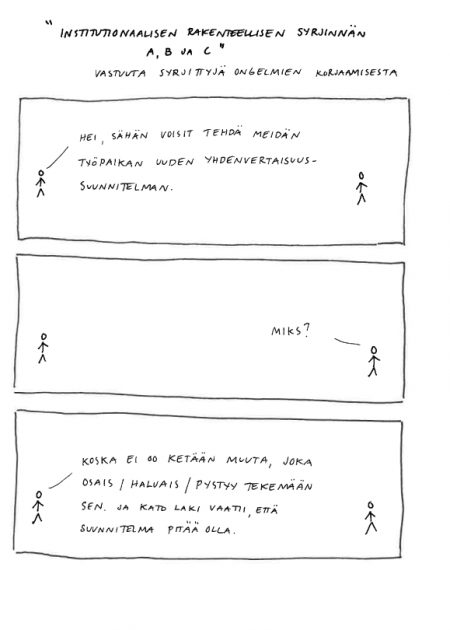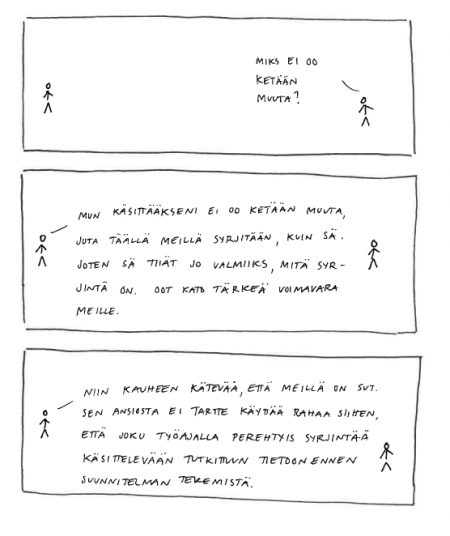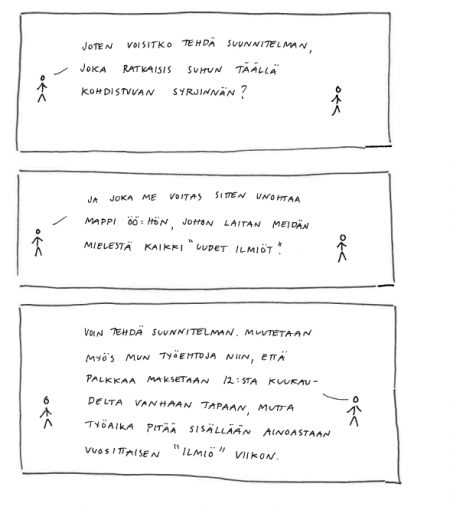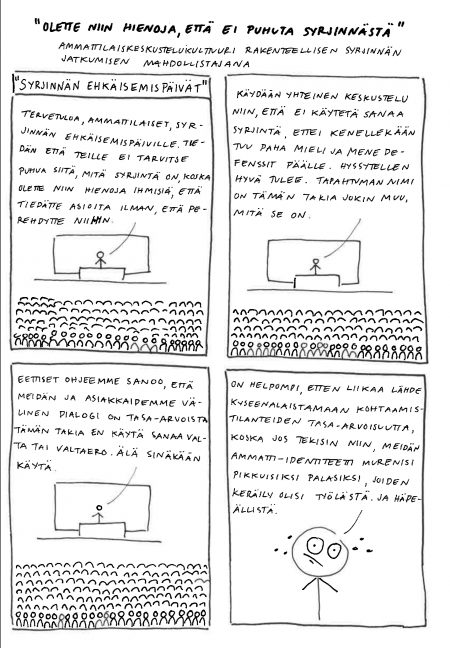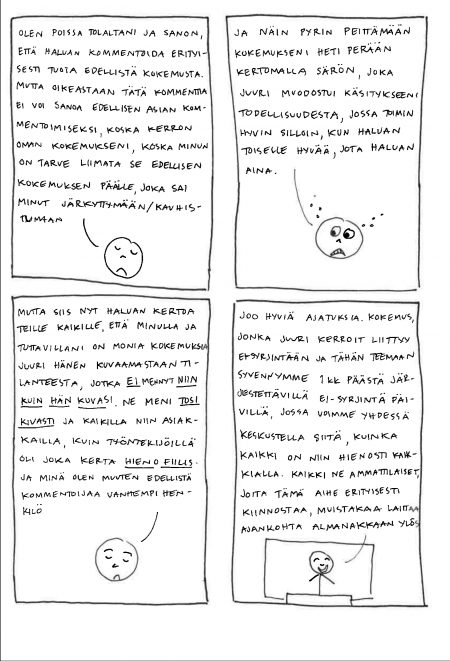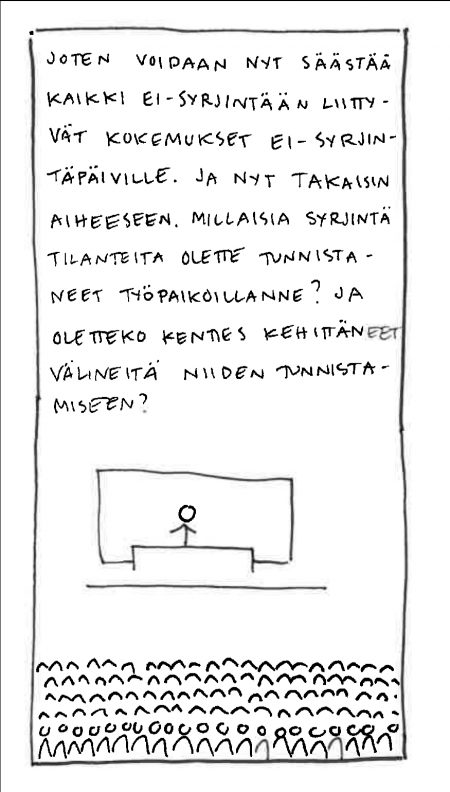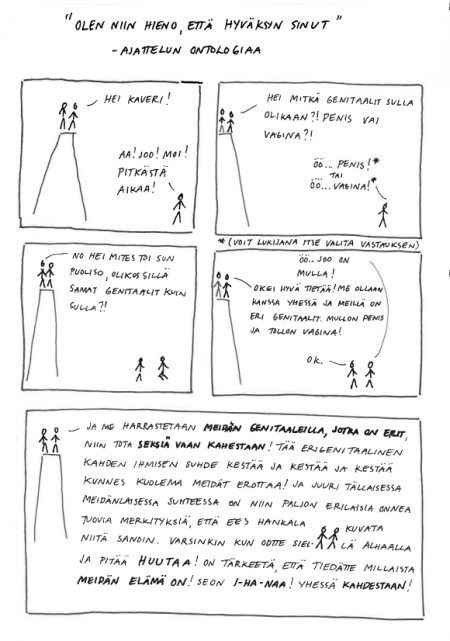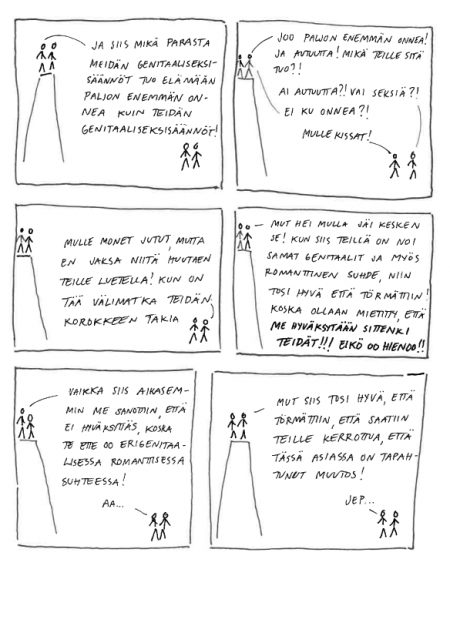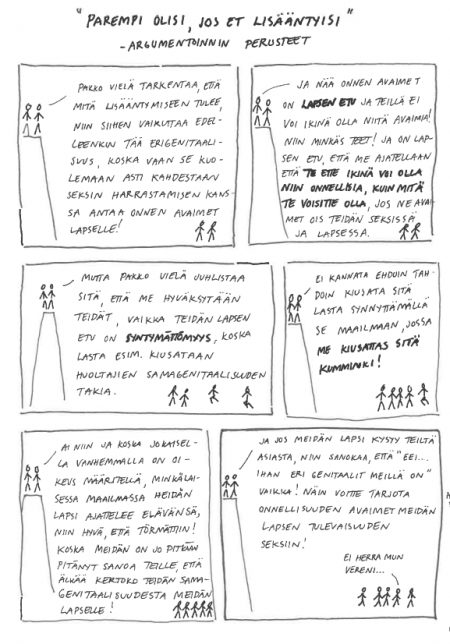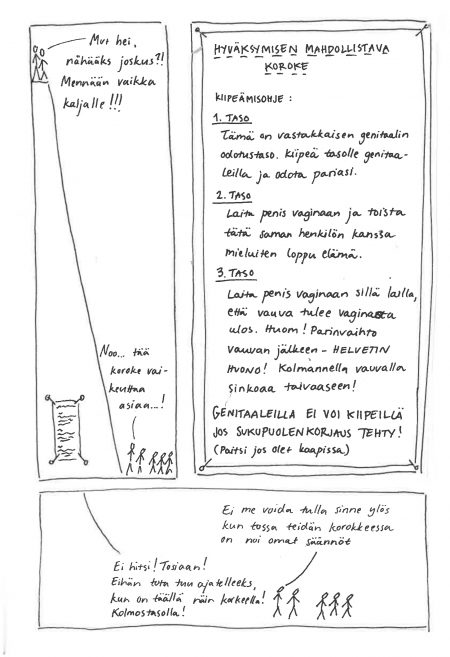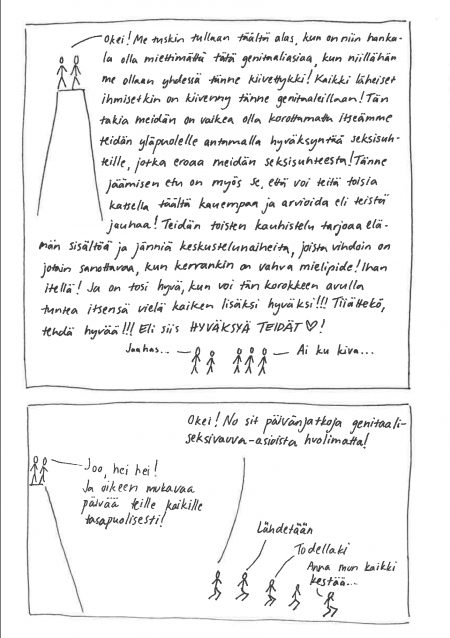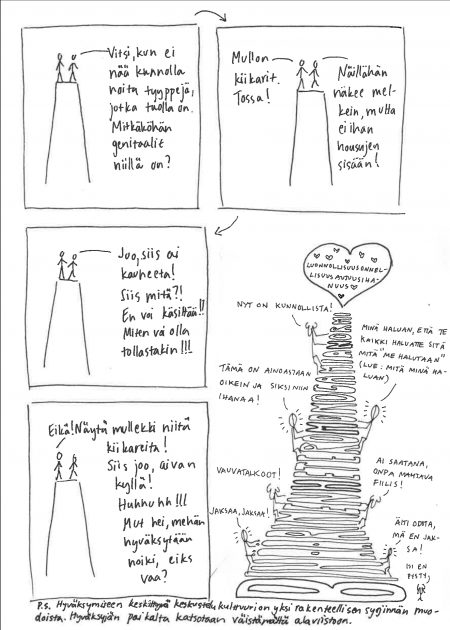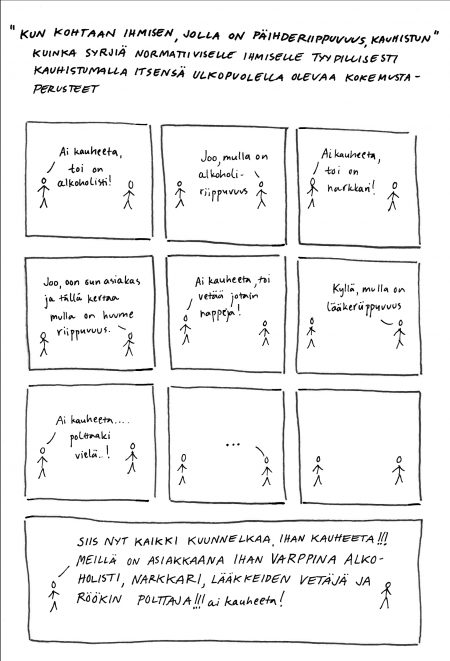
”When I meet a person, who has drug addiction, I get horrified” How to discriminate in a way that is typical to normative person and get horrified when meeting a experience that is outside of one’s own experience world -basics 1.Oh my God, that’s drunkard! 2. Yes, I have alcohol addiction. 3. Oh my God, that’s a junkie! 4. Yes, I am your client and I have drug addiction. 5. I’m so horrified, that person is taking some random pills! 6. Yes, I have medicine addiction. 7. Oh my God, that person smokes even! 8. … 9. 10. HEY EVERYBODY LISTEN TO ME, THIS IS HORRIFYING!!! I’M SURE THAT WE HAVE HERE A CLIENT THAT IS JUNKEY, DRUNK, RANDOM PILL EATER AND SMOKER! This is horrifying!
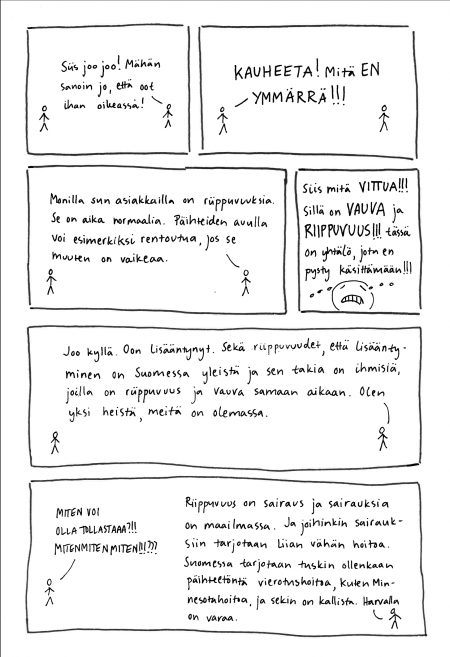
1.Yes yes! I just said, that you are right. 2. THIS IS HORRIFYING! I CAN’T UNDERSTAND! 3. Many of your clients has addictions. It’s quite normal. With different kind of intoxicants you can relax if it’s harder for some reason other ways. 4. What the FUCK! It has a BABY and ADDICTION! This is something that I can’t understand! 5. Yes I have reproduced. Addictions and reproducing are common in Finland, that’s why there are people who have reproduced and have addiction. I am one of them and we exict. 6. How can there be something like that?!! Whywhywhy!!!??? 7. Addiction is illness and there’s illnesses in the world. It’s more easy to get help to some illnesses than others. There’s not enough drug free treatment to addictions in Finland. Like Minne-sota treatment and that’s very expencive. Many don’t afford it.
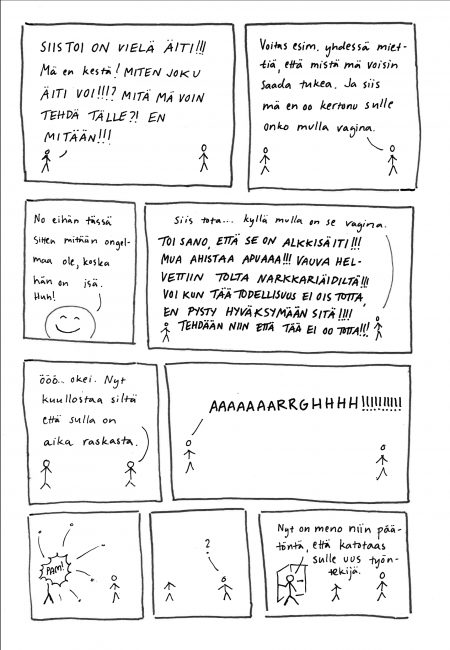
1.AND THAT PERSON IS ALSO MOTHER!!! I can’t understand this! HOW SOME MOTHER CAN!!!? WHAT CAN I DO TO THIS SITUATION?! NOTHING!!! 2. We could search together information of the question that where I can get support. And I haven’t told you weather I have a vagina. 3. Well then there’s no problem, because he’s a father. Huh! 4. Well actually …. I have a vagina. / SHE SAID THAT SHE’S DRUNK and a MOM!!! I FEEL ANXIETY, HELP MEEEE!!! LET’S TAKE BABY TO HELL FROM THAT JUNKIE MOM!!!! I WISH THIS REALITY WASN’T REAL I CAN’T ACCEPT THIS TO BE REAL!!!! LET’S MAKE IT SO THAT IT’S NOT REAL!!! 4. um…. ok. Now it looks like that you have quite hard time. 5. AAAAAARRGHHHHH!!!!!!!!!! 6. PAM! 7. ? 8. Now here is quite headless things going on so let’s get you a new worker to work with.
*********************************
Teoriaa ja ajatuksia:
Suomalainen sosiaali-, terveys- tai kasvatuspalvelun normatiivinen työntekijä odottaa asiakkaalta normatiivisuutta. Tämän sarjakuvan tilanteessa normatiivisuutta on elämä ilman riippuvuutta. Päihderiippuvuutta sairastavat ihmiset ovat syrjittyjä suomalaisessa palveluverkostosta, jossa päihteiden käytön lopettaminen toimii porttina mielenterveyspalveluiden saamiseen, vaikka todellisuudessa päihteiden käyttö tuo helpotusta mielenterveysongelmiin, joiden käsittelyyn asiakas ei ole saanut tukea. Päihderiippuvuutta sairastava tulee usein työntekijän syyllistämäksi, mutta syöpää sairastava ei. On väärin, että sairauden laatu vaikuttaa siihen, tuleeko ihminen työntekijän syyllistämäksi sairaudesta vai ei ja siihen, saako hän tukea vai ei.
Sarjakuvan kuvaama kauhisteluun perustuva syrjintä on yleistä. Kasvatusalan työntekijälle on tutkitusti tyypillistä keskiluokkaisuus, keskiluokkainen perhetausta, korkeakoulutus ja jotka individualismiin perustuvaan työotteeseen yhdistettynä johtavat hankaluuksiin ymmärtää kokemusta, joka rakentuu eri lähtökohdista, kuin mistä työntekijän oma kokemus rakentuu. Oikeutta kauhistella itsestä poikkeavia asiakkaita perustellaan usein työntekijän oikeudella ”päästellä paineita”, mutta suurissa määrin kauhistelu johtaa epärakentavan ja syrjinnän mahdollistavan keskustelukulttuurin ylläpitämiseen työyhteisössä. Kauhisteluun perustuva keskustelukulttuuri hankaloittaa työntekijäasiakassuhteen työsisällöistä ja sen haasteista puhumista ja niihin ratkaisujen löytämistä. Kun ratkaisuja ei löydy, kauhistelulle perustuva keskustelukulttuuri johtaa työntekijän ”itsen” ulkopuolella olevan kokemuksen ohittamiseen, joka on yksi rakenteellisen syrjinnän perusmekanismeista.
Sarjakuva kuvaa myös sitä, miten Suomessa vanhemmuuden tukeminen on sukupuolittunutta, jonka takia miehet/isät/miesoletetut joutuvat perhepalveluiden rakenteellisen syrjinnän kohteeksi. Syrjintään johtaa omalle normatiivisuudelleen sokean työntekijän taipumus tarjota ”yhdenvertainen” palvelukokemus ensisijaisesti itsensä kaltaisille asiakkaille, eli suomea puhuville keskiluokkaisille valkoisille naisille. Perhepalveluiden sukupuolittunutta rakenteellista syrjintää on tutkittu mm. Isännäköinen-hankkeessa (linkki alla).
Tutkimuksen mukaan Suomessa päihdepalveluita tarjotaan hanakammin äideille, naistyöntekijät soittavat mieluummin lapsen asioissa äidille, synnytyksen jälkeen mielialakysely tehdään vain äideille ja terveyskeskuksien odotushuoneessa asiakkaille on tarjolla ensisijaisesti naistyypillisiä lehtiä. Isännäköinen-hankkeen haastattelumateriaaleja lainaten ”miehet saavat repeillä aika pahasti, ennen kuin heille tarjotaan tukea.” Ammattilaiskeskusteluissa sosiaali-, terveys- ja kasvatuspalveluiden miehiin kohdistuvaan rakenteelliseen syrjintään tarjotaan ratkaisuksi sitä, että miestyötekijöiden määrää lisättäisiin. Toisin sanoen toivotaan, että alan syrjimän väestönosan tulisi korjata itse alan syrjivät rakenteet. Tämä on hyvä esimerkki siitä, kuinka velvollisuutta kohdella työajalla ihmisiä yhdenvertaisesti sukupuolesta riippumatta ollaan valmiita väistämään viimeiseen asti.
Tilanne, jossa työntekijä kaipaa asiakkailtaan itsensä kaltaisuutta, jotta voi saada onnistumisen kokemuksia asiakkaiden kanssa työskentelyssä ja viestinnässä, estää palveluiden yhdenvertaisuuden kehittymistä. Jos laajoja sosiaali-, terveys tai kasvatuspalveluita tarjoavassa työpaikassa työskentelevä työntekijä ei pysty hyväksymään sitä, että hän ei voi toivoa työltänsä sitä, että voisi työskennellä vain itsensä kaltaisten asiakkaiden kanssa, palveluiden kehittyminen yhdenvertaisempaan suuntaan ei ole mahdollista. Asiakkaiden kauhistelu on syrjintää ja kiusaamista, vaikka se tapahtuisikin suljettujen ovien takana työyhteisössä.
Lisää tietoa
https://www.xn--isnnkinen-w2ac1t.fi/
https://www.xn--isnnkinen-w2ac1t.fi/isatyokirja/
https://www.ruskeattytot.fi/rtmedia/kaikkienkoulu
McIntyre, A. 1997. Making meaning of whiteness: Exploring racial identity with white teachers. Albany: State University of New York Press.
Hökkä, P. 2012. Teacher educators amid conflicting demands: Tensions between individual and organizational development. Jyväskylä: University of Jyväskylä.
Rantala, J., Salminen, J., Säntti, J., Nikkola, T., Rautiainen, M., Virta, A. & Kemppinen, L. 2013. Akateemisen luokanopettajakoulutuksen tulevaisuuden lähtökohdat. Teoksessa Salonkikelpoiseksi maisterikoulutukseksi – Luokanopettaja- ja opinto-ohjaajakoulutuksen akatemisoitumiskehitys 1970-luvulta 2010-luvulle. Kasvatusalan tutkimuksia 64, 189-199. Jyväskylä: Jyväskylän yliopistopaino.
******************************”
Some theory and thoughts:
(Firt of all, sorry that all of the text is not translated to english. All the main points are. The reason for that is that it’s translating all the text is too hard. If you love translating texts, here is a text to fulfill translation needs <3 ) )
In Finland normative worker in a social, health or educational service expects the client to be normative. This cartoon is about a situation, where being normative means not having an addiction. People living with an addiction are discriminated in services, when services can for examble demand person to quite using drugs before person get’s access to mental health services. In reality drugs provides relief to mental health problems, that you haven’t got any help to. It’s wrong that the disease you have affects to the fact weather you are going to be blamed of the disease or not.
This cartoon also illustrates the gendered nature of institutional discrimination in parenting support services that leads to structural discrimination against men / fathers / assumed male/ presents as male. According to the study, in Finland help to addictions is more often provided to mothers, women workers prefer to call mother when talking about children, after the birth only mothers do mental healt survey and in health centers waiting rooms there are primarily ”womenmagazines” available. Men has to be in a quite bad situation before support is offerd to them. In professional discussions to increasing the number of male workers in the sector is offerd as a solution to structural discrimination against men in social, health and education services. In other words, once again those who are discriminated should repair the discriminatory structures. This is a good example of how workers are ready to not take the resposibilty to treat people equally during working hours, regardless of gender.
A situation in which an worker can’t provide good communicaiton to everybody because of the hope that client/customer would be like the worker (finnish speaking, midleclass women) prevents the development of equality of health-, social and educationservices. If a worker get’s horrified of customers’ life, it is discrimination and bullying, even if it takes place behind closed doors in the work community.
More info:
https://www.ruskeattytot.fi/about-us/
McIntyre, A. 1997. Making meaning of whiteness: Exploring racial identity with white teachers. Albany: State University of New York Press.
Murrell, P. C. 2007. Race, culture and schooling: indentities of achievement in Mulricultural Urban Schools. New York: Erlabaum.
Scott, K. A., & Boudon, D. J. (2009). Race, culture, and schooling: Identities of achievement in multicultural urban schools. The Journal of Negro Education, 78, 1, 95-96. Viitattu 22.11.2019. https://search-proquest-com.ezproxy.jyu.fi/docview/222106174?accountid=11774
In finnish of fathers:
https://www.xn--isnnkinen-w2ac1t.fi/isatyokirja/

